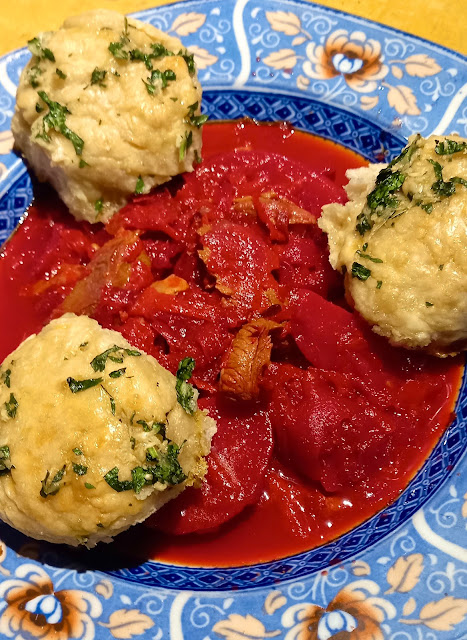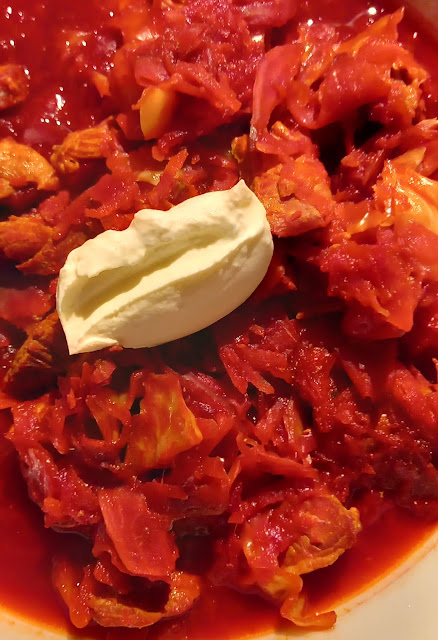Borsch for Ukraine ( Iconic soup made easy )
 |
| 415,936 pounds raised |
There is also a Polish borsch and although having not genned up so I don’t know as much about it, I
know that it, not surprisingly, also features beets.
So what goes into this iconic soup? Apparently the truth is that the recipe ingredients vary by country, region and households. However, several ingredients stay unchanged and they are the ones that make a soup into borsch .Beetroot, cabbage, onions, celery, potato, carrots. Every building needs a solid foundation and every soup starts with a great stock. Making a delicious stock is by far the most time consuming part of this recipe. It’s not difficult, it just takes time .The best flavour comes from meat on a bone, simple vegetables and a couple of aromatics, peppercorns and bay leaf. Once the stock is made and clarified, the soup itself takes no more than 30 minutes to make.If you are short for time, I recommend making the stock the night before. There is no specific technique that is needed for making an authentic Russian borscht, but you do need to add vegetables in a specific order to ensure they all get cooked to perfection in the end. For example, cabbage doesn’t take too long to cook and therefore needs to be added last.
Lastly, grated carrots and chopped onions are always sautéed in sunflower oil until caramelised and added to borsch towards the end. This method is called “zazharka” in Russian and Ukrainian cooking.
Many cooks do the same with beets, but sautéing beets separately only adds more unnecessary steps to the recipe and doesn’t contribute anything to the flavour. I skipped the sautéing and added raw grated beets directly to the soup. Borsch is almost always served with a dollop of smetana or sour cream and sprinkled with fresh herbs like dill or parsley. Pampushky, or garlic doughnuts, are also the most usual accompaniment to this delicious red-coloured soup. The recipe I used was that of Oliah Hercules father who put a little twist on it at the end of making it, which appealed to me. Her father she claims is an often a slightly eccentric, but excellent cook. When her son was born, him being half Thai, her dad decided that adding Asian ingredients to Ukrainian food was the way to go. "He made a borscht and added a bruised chilli (which isn’t that out of the ordinary for Ukrainian borsch, but he added ginger too, which added gentle warmth to the whole affair. He usually uses pork ribs, but you can use anything at all – beef or pork bones, chicken carcasses and even giblets that you may find in your freezer work, just make sure to take the liver out. For a veggie option, make a dried mushroom stock".
Papushka’s borsch
Serves 4
pork ribs 2kg
onions 2, peeled
carrots 2 medium, scrubbed, 1 roughly chopped and 1 grated
celery 2 sticks, chopped
bay leaf 1
allspice berries 10
peppercorns 10
salt
beetroot 2 medium, peeled and julienned
chopped tomatoes 1 x 400g tin
red chilli 1, bruised with the side of a knife
potatoes 4 small, peeled and cut into 8 wedges, or ½ celeriac, peeled and diced
savoy cabbage ¼, sliced
garlic 2 cloves, peeled and finely grated
ginger 5cm knob, peeled and finely grated
chopped dill 2 tbsp
Meanwhile, skim the top of the stock with a ladle. You are collecting the fat – do not discard it! Pour it into a large, deep frying pan and let the extra water sizzle off, leaving you with just the fat. Dice the other onion and add it to the frying pan. Cook it over a medium heat until it starts turning golden. If it goes too dry, add some more fat from the stock. Then add the grated carrot and cook some more until the carrot is also soft. Then add the beetroot and cook for another 3 minutes. Finally add the tinned tomatoes and bruised chilli and season well with salt and pepper.
Strain the stock into a large bowl, discard the veg but add the meat back in – if the ribs are properly falling apart, get rid of the bones – and pour it all back into the pot. Add the frying pan contents into the stock along with the potatoes or celeriac. Cook for 5 minutes, then add the cabbage. It is done when the potatoes or celeriac are cooked, but not too soft.
Make sure you taste for seasoning, then add the grated garlic and finely grated ginger at the very end. Serve with plenty of dill or your favourite soft herbs.
Are you cooking for Ukraine?,thinking about it? or would make donation?
https://www.justgiving.com/fundraising/cookforukraine/





Comments
Post a Comment